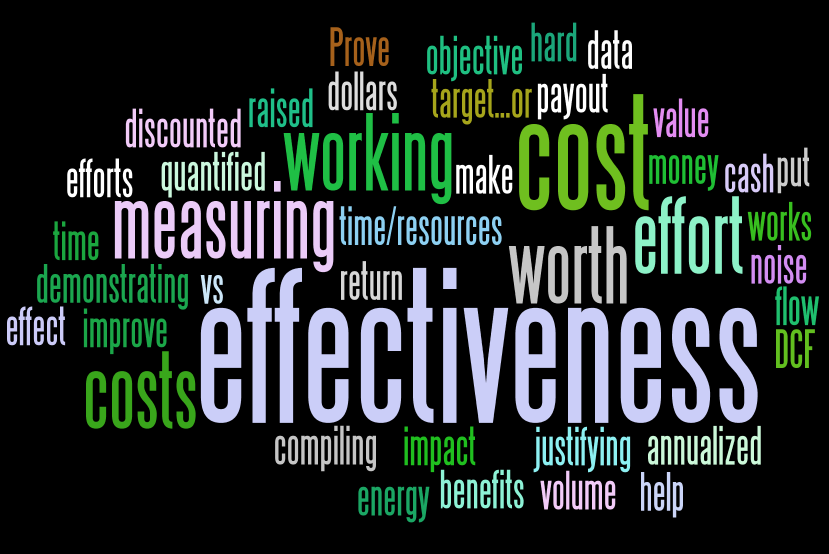 The three little words “return on investment†may be the stuff of every marketers’ dreams or nightmares, depending on how their campaigns and initiatives are performing. Every company has limited resources and in order to justify continued expenses and expenditures, marketers are increasingly pressured to provide a reason, through excellent ROI, to keep or increase their budgets. In fact, nearly two-thirds of CMOs believe that ROI will be the principal measure of performance by 2015.
The three little words “return on investment†may be the stuff of every marketers’ dreams or nightmares, depending on how their campaigns and initiatives are performing. Every company has limited resources and in order to justify continued expenses and expenditures, marketers are increasingly pressured to provide a reason, through excellent ROI, to keep or increase their budgets. In fact, nearly two-thirds of CMOs believe that ROI will be the principal measure of performance by 2015.
As many marketing initiatives increasingly position themselves online, where clicks, conversions, traffic, purchases and other deliverables can be easily measured, ROI will grow as a primary means of measurement for marketing. Additionally, this numbers-driven “yardstick,†gives marketing executives the opportunity to provide hard numbers and data when competing against other departments for budgetary funding. Marketing budgets are often the first ones cut since there previously was no way to see how efforts and initiatives were affecting the bottom line. ROI helps combat that lack of awareness.
Marketing campaigns are considered investments by many businesses, with the expectation that a certain amount of profit, conversion or traffic should be the result of the money spent. As with any other venture, measurements are needed in order to ensure that the campaigns are worthwhile investments.
What components you will need to calculate for a quick “temperature reading†on ROI for your marketing campaign. The math for ROI calculation is generally fairly straightforward, and depending on what you’re measuring, sometimes the analytics tool you use to gather data can do the math for you.
The basic components of an ROI calculation can be a challenge to figure out, but should at least include revenue or conversions generated by a specific marketing campaign, and marketing-related expenses—including manpower and hourly wages. Profit margins on product should be included if the marketing is product-driven. You’ll also need to determine the value of each new conversion (newsletter sign-up, registration, etc.) if you’re not measuring purchases. For example, each new registered member averages to $1000 in sales over next two months; so one registration is worth $500 a month, even if you’re not measuring direct purchases for that particular campaign.
These elements are needed for a very quick read on how your campaigns are performing, so that you can get a sense as to whether or not you want to continue, adjust, or kill the initiative.

By SK (FED Architected Agile Template) [CC-BY-SA-3.0 (http://creativecommons.org/licenses/by-sa/3.0)], via Wikimedia Commons
However, measuring ROI on marketing campaigns can be challenging. Getting an accurate read on your marketing ROI can be rather tricky as there are many moving parts that need to be taken into consideration.
When to measure. Depending on the campaign, the results may not be immediate. The money spent today on this advertising campaign may not result in major conversions until a week from now. Last month’s advertising spend may still be leading to the spike in traffic this month. As there isn’t a set time limit on the effects of a marketing initiative, it can be difficult figuring out firm numbers for each effort.
More than one point of attribution. Unless you are running one campaign at a time, in complete isolation from any other efforts, you may not know if it was this particular initiative alone that lead to the conversion or purchase, or if it was the three previous efforts that led this customer to finally convert. It can be difficult to attribute a new customer or purchase to just one campaign.
Spending levels. ROI changes at different spending levels. Unless you’re investing exactly the same amount of money and time into each campaign, comparing ROIs would give you an inaccurate read on performance.
 External variables. Your marketing efforts aren’t working in a vacuum—many outside factors, either from your business or the world at large, can have an effect on how your campaign performs. Panic about a potential financial crash can tank the ROI of an effort that would otherwise be successful during calmer economic times. Conversely, an upswing in consumer confidence and spending, may inflate ROI.
 Focusing solely on ROI may sell the marketing campaign short. While looking at cost of investment and return can give you a quick overview of how the marketing efforts are performing, it also overlooks many important factors that also play a part in the reach and influence of the marketing campaigns.
 If you do need a number to determine whether or not you’re overspending or under-spending on a campaign, consider measuring return on marginal investment instead. It can quickly give you a sense of whether you need to adjust your spend—and all you need to know is if the ROI is positive or negative.
 Every marketer, online or otherwise, needs to have some sort of gauge for their performance, especially in a numbers-driven business world. ROI can help provide those much needed numbers; but keep in mind that it may not reflect the big picture and overall affect of marketing efforts.
Dave Landry Jr. is an investor and small-business owner, contributing to National Debt Relief, a proven agency supporting those in financially dire situations.
This entry was posted in Guest Writers, Learning Resources by Dave Landry. Bookmark the permalink. Image courtesy of Beth Kanter / Flickr.com
Â